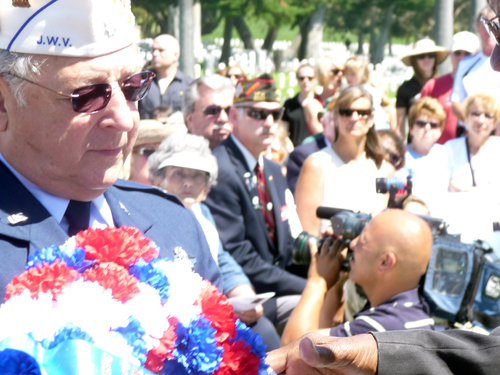
By Donald H. Harrison

SAN DIEGO—As the California commander of the Jewish War Veterans, Allen Miliefsky kept a busy patriotic and inter-religious schedule on Memorial Day. At Fort Rosecrans National Cemetery, he and JWV Post 185 commander Rick Nathanson laid a wreath at the Casket of the Unknown, and later dedicated a small monument honoring the contributions of Jewish military personnel to the United States.
From there, Miliefsky and his patriotically bedecked wife, Josie, drove to Mount Soledad, where in his blue U.S. Air Force uniform, something of a rarity in this city known for its Navy and Marine Corps personnel, the retired lieutenant colonel sat in the front row of the audience, within viewing distance of his own plaque on one of the memorial walls under Mount Soledad’s large and controversial centerpiece Christian cross. His plaque, including a Jewish star and a JWV emblem, honors Miliefsky’s service as an Air Force navigator during the Vietnam War.
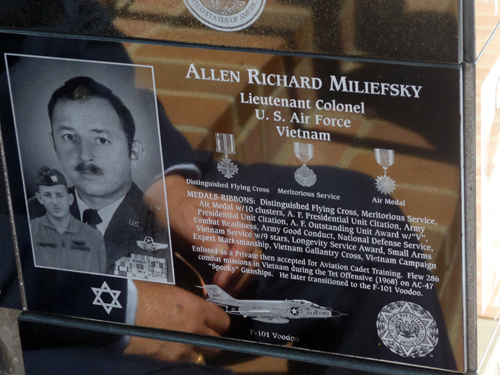
At each venue, prominent members of the Jewish community were participants in the Memorial Day observances. For example, the Jewish community chaplain, Rabbi Ralph Dalin, whose father was an Army lieutenant colonel during World War II, delivered a well-received invocation at the main Fort Rosecrans ceremony, saying that remembering is both a commandment and a gift. “We who are indebted to those of the military buried here or elsewhere are privileged to be able to remember them, and to remember what they did on our behalf,” Dalin said.
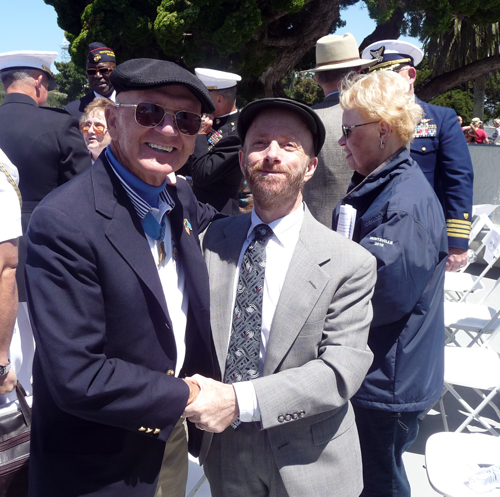
Rabbi Ben Leinow, known for his interreligious and social welfare work in the North County and as the chaplain for the Escondido Police Department, officiated at the subsequent dedication service for the JWV monument. The second ceremony drew, among others, San Diego City Councilwoman Marti Emerald, who was visiting the national cemetery for the first time since her husband, S. Myron “Mike” Klarfeld, had been buried there in March.
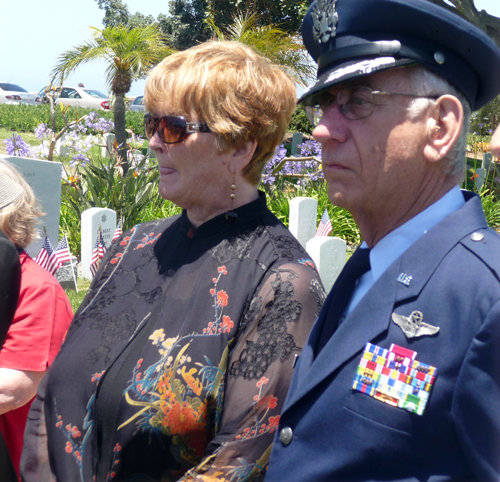
“Very often we focus on the heroes who fall in battle,” said Rabbi Leinow, “and we don’t focus as much on those who make it through but in the process of going through the battle are touched by the experience of what they had to go through to stay alive. Sometimes that includes physical injury and sometimes that includes emotional injury, but no matter what happens all of us are touched in a very strong and powerful way by those experiences.”
“Although this is a monument for the Jewish War Veterans, we recognize that we are part of a larger complex—a coming together of people who want to become comrades; men, women, people of all color, white, black, brown, whatever their background might be, coming together to try to create that better world through a partnership…” said Leinow.

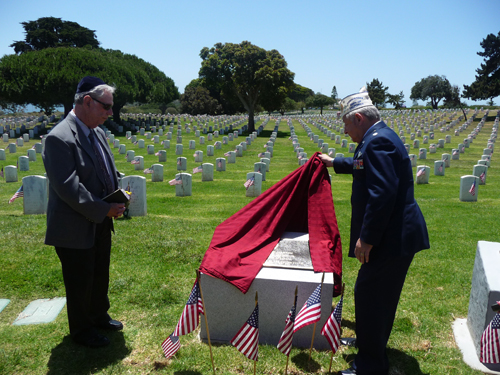
After unveiling the plaque, Miliefsky read its inscription: “In honor of the men and women of the Jewish faith who gave their lives in service to their country, these United States of America. — Jewish War Veterans of the United States, dedicated Memorial Day 2011.”
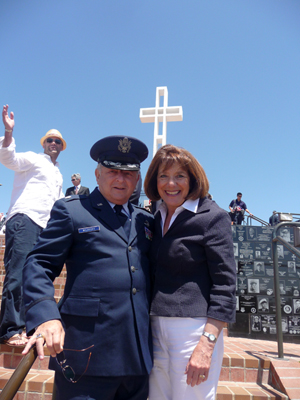
At Mount Soledad, Congresswoman Susan Davis, a member of the House Armed Services Committee and Jewish community member, sat on the dais, in a ceremony that was highlighted by a memorial tribute to World War II Marine Corps Pilot Gregory “Pappy” Boyington, who commanded the “Black Sheep Squadron” in the Pacific Theatre and was awarded a Navy Cross and a Medal of Honor. Boyington’s son, Greg, participated in the observance. The exploits of the “Black Sheep Squadron” were celebrated in a television series of the mid-1970s starring Robert Conrad as “Pappy” Boyington.
A living Medal of Honor recipient, Marine Corps. Col. (ret) Robert J. Modrzejewski, attended the main commemoration at Fort Rosecrans, drawing appreciative handshakes from civilians and salutes from military for his valor during the Vietnam War. Surrounded by a regiment of enemy soldiers, he inspired his company K to fend off the attack, always in the thick of the fighting despite being wounded, according to a citation presented to him in 1966 by President Lyndon B. Johnson.
In a day of band music, speeches, prayers, homage to the flag, gun salutes (with the addition of a canon at Fort Rosecrans, which set off nearby car alarms with its boom), and a fly-by of the T-34 Performance Team at Mount Soledad, Memorial Day 2011 was the kind of day on which memories are built.
*
Miliefsky, who grew up in Worcester, Mass., enlisted at age 17 in the Massachusetts Air National Guard in 1956, and eventually transferred to the Air Force, where he attended electronics school and was made an instructor. Next, he was accepted in the Aviation Cadet program, expecting to become a pilot. However, during one flight, he passed out, “and they couldn’t figure out why and so then they sent me to navigator training.” During the Vietnam War, he flew from Da Nang Air Force Base an AC-47, an aircraft which was nicknamed “Puff the Magic Dragon,” an attack version of the C-47, with Gatling guns on the side.
“I ended up with 258 missions,” he said. “We lost 12 aircraft because we flew during the day. They decided that the plane was too slow and too easy to shoot down so we went to night flying. In night flying, I ended up with 361 holes in the airplane. What that was from was that the barrel clamps on the electric mini-guns would overheat during a real hot battle, and the gun barrels would spread from the heat, and shoot up one of our wings before we could get the finger off the trigger. And it put 120 holes exactly each time – so that was 360. Only one hole was from ground fire!”
Miliefsky said of all the missions he flew, two in particular will stand out in his memory. “One was the one for which the crew won the Distinguished Flying Cross. Just south of Da Nang there was a Special Forces outpost and it was being overrun. What we did was to go on combat air patrol over the base until we get a call for a target. We got a call from down there, and they told us they were ‘on the wire,’ which means that they were in too close for us to fire. So we told them to drag metal, wood, anything over their heads, and tell us when they breached the wire, and as soon as they did, we waited another minute and then we sprayed the whole camp. I’m sure that we killed some Americans, but they all would have been dead anyway. It saved the outpost from being overrun, and the next day, when they sent a helicopter up for us, picked us up, brought us down to the camp, and made us a steak dinner, and then they took us out on a patrol. We had killed 140 of the enemy, and they were all lined up on Highway 1 there to show the Viet Cong. The Americans didn’t do that, the ARVN (Army of the Republic of Vietnam) did.”
The other memorable mission was when a mountain outpost had been overrun and “we were to stay there all night and fire to keep the enemy off the dead soldiers and collecting their ammunition and guns. While we were doing that I got a call from a radio down on the mountain and he said, ‘there are two of us still here.’ One was a Marine, he was okay; the other was a Navy corpsman, and we told him to give the radio to the corpsman and go collect the guns. Later, the corpsman called us and wanted us to take a message to his girlfriend. We said, ‘there will be a helicopter for you at first light, you’ll be fine.’ He said, ‘no, I’m a corpsman, and I’m wounded and I’m not going to make it.’ We took a message, and in the morning, they were airlifted out of there. We called the hospital and he did not make it.”
*
The national organization of the Jewish War Veterans is a substitute plaintiff in the long-pending class- action lawsuit brought by the American Civil Liberties Union challenging the constitutionality of the Christian Cross on Mount Soledad, which once was city land and by action of the Congress was later transferred to federal ownership. Originally, the suit had been brought in behalf of Philip Paulson, an atheist, but after he died of liver cancer, the JWV agreed to serve as a plaintiff. Miliefsky said he was caught unaware by the national action, which he said he disapproved.
“I can understand why they did it—for reasons of Separation of Church and State,” he said. “But I think they should have stayed out of it.” Miliefsky said if he had his druthers, something other than a cross would tower over the memorial walls with its 3,000 plaques.
“They could have used something better like an upside down rifle with a bayonet in the ground and a helmet on top; that would have been a good symbol. Another one is a GI with an M-16 across his shoulders with his arms over it; and there you have the shape of the cross, but it is a neutral monument.”
The matter is in the courts, he said, and “if the law says it comes down, it comes down, and if it says it stays up, it stays up. And the Jewish War Veterans won’t really affect this. So why stick your name in it and like you’re rubbing everyone’s nose in the dirt. Let the ACLU take care of it. We have to live here. I got calls like you wouldn’t believe when it (news of JWV joining the suit) came out in the paper. Christians who said they had donated money to Israel, and this and that, and I said, ‘well, the whole thing is news to me too.’”
Miliefsky noted that there are Jewish symbols on government property. “The Touro Synagogue in Newport, R.I., is on government property, and it’s a synagogue,” he said. In San Diego, the historic Temple Beth Israel, with its Stars of David and Tablets of the Law, stands in county-owned Heritage Park.
Noting that the cross has been standing on Mount Soledad since 1954, when it was dedicated for Easter Sunrise Services, Miliefsky added; “It’s almost like eminent domain.”
Asked why he had a plaque placed in his honor at the Cross site, he responded: “I live in this community, and this way nobody at the United Veterans Council, which is the first Veterans Council in the United States, is going to bad-mouth Jewish War Veterans…”
If Miliefsky is somewhat ambivalent about the Cross issue, during the Memorial Services at the Mount Soledad cross, speaker after speaker was adamant about their belief that the Cross belonged.
William Kellogg, chairman of the Mount Soledad Memorial Association, said, “It is astounding to me that anyone, other than our enemies, could object to a monument erected to remind us of the exploits of those brave patriots who gave their lives serving the United States military in the Korean War, but in this strange world anything can happen. I know that many of you share my sadness that the monument behind me remains under legal attack. Please know that the Mount Soledad Memorial Association remains firm in its resolve to fight the forces that would tear down the original memorial. We will not rest until this battle is won.”
After the cross was first challenged legally in 1989, the site eventually was transformed into the war memorial it is today with 3,000 black granite plaques, and more to come, honoring the military service of as many individuals. “We have this flagpole which proudly flies the Stars and Stripes,” said Kellogg. “Old Glory is raised and lowered every day by one of our volunteers. We educate the community about what this monument stands for and yet we still have much more to do.”
He said that whatever happens to the Cross as a result of the law suit, the rest of the monument will stand. “Recently the Liberty Institute joined with our Association to mount a strong legal defense of this monument in court,” he added. “The Institute is a Texas-based non-profit law firm that successfully defended the Veterans Cross in the Mojave Desert before the U.S. Supreme Court. They represented the VFW, the American Legion and the Military Order of Purple Heart for years. They understand the importance of this monument to our community and they are doing this at no cost to our association..”
San Diego City Councilman Kevin Faulcomer also publicly pledged his support for keeping the cross in its prominent location.
*
Harrison is editor of San Diego Jewish World. He may be contacted at donald.harrison@sdjewishworld.com